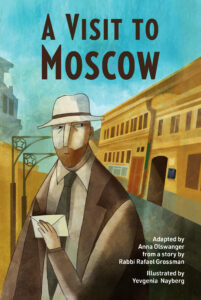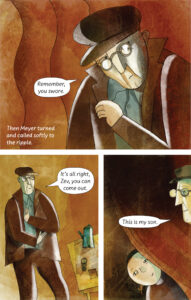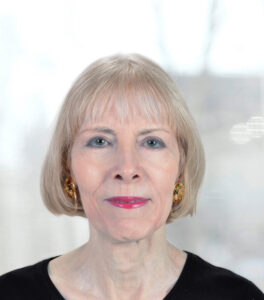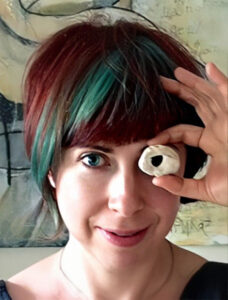“Tackling My Own Book’s Educators’ Guide”
Near the bottom of this page is a download link to the student guide for A Visit to Moscow. If you open the link, you’ll discover several discussion questions, beginning with this one:
“Rather than opening directly with the Rabbi’s arrival in Moscow, the book opens and closes with Zev’s dreamlike, enigmatic vision. Why do you think the author chose to bookend the story with these sequences? From whose perspective or perspectives are we experiencing this story?”
When Creators Assemble! (the nonprofit that works to bring graphic novels into educational spaces) was developing the guide, I wondered how I would answer the question myself. Why did I bookend the story of Zev’s vision? Why didn’t I just tell the simple, chronological story of the rabbi visiting Moscow and discovering Zev as a little boy, hidden away by his parents to protect him from the Soviet government’s antisemitism? Why add the dream-like, enigmatic opening and ending?
The simple answer is that, like any author, I wanted to add my own thumbprint to a story I had heard. I wanted to make it my own. But then I thought about where my part of the book had come from.
In listening to the story that would become A Visit to Moscow from Rabbi Rafael Grossman, the inspiration for the rabbi character in the graphic novel, I asked him endless questions about the real Zev and his family. I wanted to understand how the little boy, who had never been outside the room he was born in, would view the world. Would he be angry? Would he be afraid? Would he be bitter?
Zev, the little boy, later told Rabbi Grossman that when his mother was sleeping, he would turn the shade a little to see what was outside. Zev knew that in the winter it snowed. He knew there was rain. He knew when it was warm and when it was cold. As he looked out the window, he wondered about the world. He thought it was made up of mean people because he couldn’t go out and play, but—Rabbi Grossman emphasized—Zev never thought the world was ugly. He wanted to know more about it.
As soon as Rabbi Grossman arranged for the family’s visas to Israel, Zev and his parents were put on a flight to Europe. Zev thought the car that took them to the airport was an incredible thing. The airplane totally fascinated him. He talked about it later at his bar mitzvah in Israel and said he went up to God and then came down.
Rabbi Grossman said that when he visited the family in Israel, Zev ran around showing him things: his school books, his soccer ball, his kippah. Zev was excited and full of life, introducing his pals to the Rabbi, shouting, singing–not at all restricted. He seemed to love everything about his life.
Rabbi Grossman said Zev was extremely happy in Israel. His life was filled with learning the language, making friends, and playing sports. He traveled on buses and went to every part of Israel. Later, he went to a hesder yeshiva (a yeshiva program that combines advanced Talmudic studies with military service in the Israel Defense Forces) and received a degree in mechanical engineering. He married and had children. And through it all Zev had a very strong, loving relationship with his parents. Zev talked about the world as a beautiful place. He talked about Lebanon and how the mountains were extraordinary.
Lebanon, where as a young man he stepped on a land mine while on reserve duty and was killed.
That view of the world as an extraordinary place sustained Zev, whether in the one room in Moscow where he could only peek out the window or in the openness of the land and cities of Israel. I think for him, being alive on this earth was like being in heaven.
And that is what I added to the story to make it my own, Zev’s feeling of being alive on this earth. It’s why I added the opening where the adult Zev has just died and is looking down at the area in Lebanon where he stepped on a land mine and sees the lush landscape—a river, haze, the ruins of a rampart. He thinks he’s looking down from heaven, and then everything starts to disappear. He can’t remember his name or who he was. He hears a voice and follows it. He sees a man (later we realize it is the fictional version of Rabbi Grossman, the rabbi who visited Zev and his family in the Soviet Union) at his Shabbat table with his family. The man is about to tell his family a story, and the story is his meeting Zev and his parents during a visit to Moscow. I then added the ending where Zev remembers all the events in the book, realizes he has died, remembers he has been alive. That was where I added the line, “He remembers being alive was like being in heaven.”
The book couldn’t have been just the simple story of what happened to Rabbi Grossman. It had to include what Zev knew, what Rabbi Grossman knew, and what I came to know through hearing the story, writing it, and reading it—that this world, in all its richness, is heaven.
Will students have any idea about my reason for including the mystical bookends to the story as they try to answer that question in the student guide? No, but they might imagine a reason, and that is the start of making sense of what we experience in life and making our own story part of life’s big story. Hearing a story we don’t quite understand and working to make sense of it by filling in the blanks is, at least for me, what being a human in the chain of history is about.
Published May 24th, 2022 by West Margin Press
About the Book: This haunting graphic novel takes place in 1965 when an American rabbi travels to the Soviet Union to investigate reports of persecution of the Jewish community. Moscow welcomes him as a guest—but provides a strict schedule he and the rest of his group must follow. One afternoon, the rabbi slips away. With an address in hand and almost no knowledge of the Russian language, he embarks on a secret journey that will change his life forever. Inspired by the true experience of Rabbi Rafael Grossman, A Visit to Moscow conveys the spiritual Holocaust and devastating antisemitism that existed in the Soviet Union, and the commitment of one Jew to bringing the horrifying reality into the light. It offers a window into the bias that still exists against Jews today, both in Russia and in America. This brief, beautiful, digestible visual narrative is a perfect on-ramp for student interest in the history of religious persecution, the oppression in the Soviet Union, and the experience of the Jewish people at large. It’s a wonderful tool for teachers—approachable, brief, illustrated. A volume that can be read and discussed in a 40-minute class or used as the foundation for broader study.
2023 Eisner Award Nominee, Best Adaptation from Another Medium
2022 Brightness Illustration Award Longlist
About the Author: Anna Olswanger first began interviewing Rabbi Rafael Grossman and writing down his stories in the early 1980s. She is the author of the middle grade novel Greenhorn, based on an incident in Rabbi Grossman’s childhood and set in New York in the aftermath of the Holocaust. She is also the author of Shlemiel Crooks, a Sydney Taylor Honor Book and PJ Library Book, which she wrote after discovering a 1919 Yiddish newspaper article about the attempted robbery of her great-grandparents’ kosher liquor store in St. Louis. Anna is a literary agent and represents a number of award-winning authors and illustrators. Visit her at www.olswanger.com.
About the Illustrator: Yevgenia Nayberg is an award-winning illustrator, painter, and set and costume designer. As a designer, she has been the recipient of numerous awards, including the National Endowment for the Arts/TCG Fellowship for Theatre Designers, the Independent Theatre Award, and the Arlin Meyer Award. She has received multiple awards for her picture book illustrations, including three Sydney Taylor Medals. Her debut author/illustrator picture book, Anya’s Secret Society, received a Junior Library Guild Gold Selection Award. Her latest picture book is A Party for Florine: Florine Stettheimer and Me. Originally from Kiev, Ukraine, Yevgenia now lives and draws from her studio in New York City. Visit her at www.nayberg.org.
Thank you, Anna, for this insight into analyzing your graphic novel!




